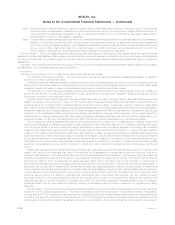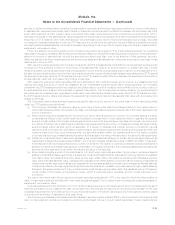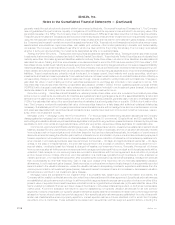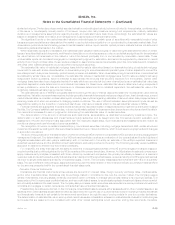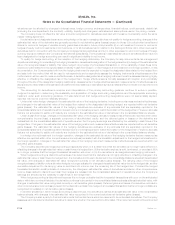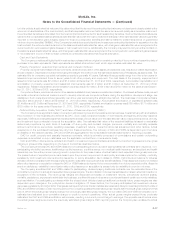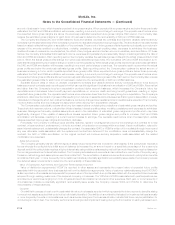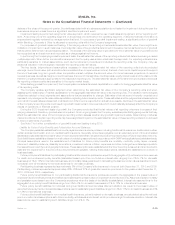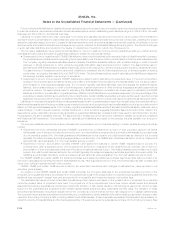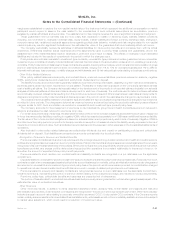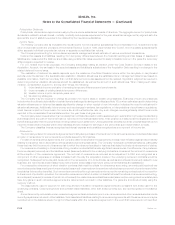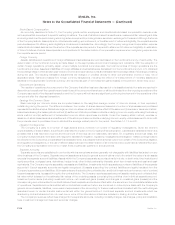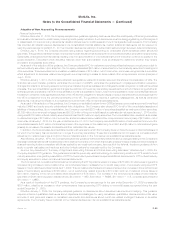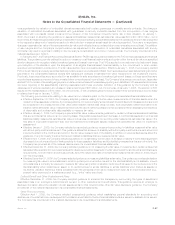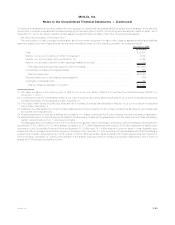MetLife 2010 Annual Report Download - page 109
Download and view the complete annual report
Please find page 109 of the 2010 MetLife annual report below. You can navigate through the pages in the report by either clicking on the pages listed below, or by using the keyword search tool below to find specific information within the annual report.Future policy benefit liabilities for disabled lives are estimated using the present value of benefits method and experience assumptions as
to claim terminations, expenses and interest. Interest rate assumptions used in establishing such liabilities range from 3% to 8% for domestic
business and 2% to 9% for international business.
Liabilities for unpaid claims and claim expenses for property and casualty insurance are included in future policyholder benefits and
represent the amount estimated for claims that have been reported but not settled and claims incurred but not reported. Liabilities for unpaid
claims are estimated based upon the Company’s historical experience and other actuarial assumptions that consider the effects of current
developments, anticipated trends and risk management programs, reduced for anticipated salvage and subrogation. The effects of changes
in such estimated liabilities are included in the results of operations in the period in which the changes occur.
The Company establishes future policy benefit liabilities for minimum death and income benefit guarantees relating to certain annuity
contracts and secondary and paid-up guarantees relating to certain life policies as follows:
• Guaranteed minimum death benefit (“GMDB”) liabilities are determined by estimating the expected value of death benefits in excess of
the projected account balance and recognizing the excess ratably over the accumulation period based on total expected assessments.
The Company regularly evaluates estimates used and adjusts the additional liability balance, with a related charge or credit to benefit
expense, if actual experience or other evidence suggests that earlier assumptions should be revised. The assumptions used in
estimating the GMDB liabilities are consistent with those used for amortizing DAC, and are thus subject to the same variability and risk.
The assumptions of investment performance and volatility are consistent with the historical experience of the appropriate underlying
equity index, such as the Standard & Poor’s (“S&P”) 500 Index. The benefit assumptions used in calculating the liabilities are based on
theaveragebenefitspayableoverarangeofscenarios.
• Guaranteed minimum income benefit (“GMIB”) liabilities are determined by estimating the expected value of the income benefits in
excess of the projected account balance at any future date of annuitization and recognizing the excess ratably over the accumulation
period based on total expected assessments. The Company regularly evaluates estimates used and adjusts the additional liability
balance, with a related charge or credit to benefit expense, if actual experience or other evidence suggests that earlier assumptions
should be revised. The assumptions used for estimating the GMIB liabilities are consistent with those used for estimating the GMDB
liabilities. In addition, the calculation of guaranteed annuitization benefit liabilities incorporates an assumption for the percentage of the
potential annuitizations that may be elected by the contractholder. Certain GMIBs have settlement features that result in a portion of that
guarantee being accounted for as an embedded derivative and are recorded in policyholder account balances as described below.
Liabilities for universal and variable life secondary guarantees and paid-up guarantees are determined by estimating the expected value of
death benefits payable when the account balance is projected to be zero and recognizing those benefits ratably over the accumulation period
based on total expected assessments. The Company regularly evaluates estimates used and adjusts the additional liability balances, with a
related charge or credit to benefit expense, if actual experience or other evidence suggests that earlier assumptions should be revised. The
assumptions used in estimating the secondary and paid-up guarantee liabilities are consistent with those used for amortizing DAC, and are
thus subject to the same variability and risk. The assumptions of investment performance and volatility for variable products are consistent
with historical S&P experience. The benefits used in calculating the liabilities are based on the average benefits payable over a range of
scenarios.
The Company establishes policyholder account balances for guaranteed minimum benefits relating to certain variable annuity products as
follows:
• Guaranteed minimum withdrawal benefits (“GMWB”) guarantee the contractholder a return of their purchase payment via partial
withdrawals, even if the account value is reduced to zero, provided that the contractholder’s cumulative withdrawals in a contract year
do not exceed a certain limit. The initial guaranteed withdrawal amount is equal to the initial benefit base as defined in the contract
(typically, the initial purchase payments plus applicable bonus amounts). The GMWB is an embedded derivative, which is measured at
estimated fair value separately from the host variable annuity product.
• Guaranteed minimum accumulation benefits (“GMAB”) and settlement features in certain GMIB described above provide the
contractholder, after a specified period of time determined at the time of issuance of the variable annuity contract, with a minimum
accumulation of their purchase payments even if the account value is reduced to zero. The initial guaranteed accumulation amount is
equal to the initial benefit base as defined in the contract (typically, the initial purchase payments plus applicable bonus amounts). The
GMAB is an embedded derivative, which is measured at estimated fair value separately from the host variable annuity product.
For GMWB, GMAB and certain GMIB, the initial benefit base is increased by additional purchase payments made within a certain time
period and decreases by benefits paid and/or withdrawal amounts. After a specified period of time, the benefit base may also increase as a
result of an optional reset as defined in the contract.
GMWB, GMAB and certain GMIB are accounted for as embedded derivatives with changes in estimated fair value reported in net
derivative gains (losses).
At inception of the GMWB, GMAB and certain GMIB contracts, the Company attributes to the embedded derivative a portion of the
projected future guarantee fees to be collected from the policyholder equal to the present value of projected future guaranteed benefits. Any
additional fees represent “excess” fees and are reported in universal life and investment-type product policy fees.
The estimated fair values of these embedded derivatives are then determined based on the present value of projected future benefits
minus the present value of projected future fees. The projections of future benefits and future fees require capital market and actuarial
assumptions including expectations concerning policyholder behavior. A risk neutral valuation methodology is used under which the cash
flows from the guarantees are projected under multiple capital market scenarios using observable risk free rates. The valuation of these
embedded derivatives also includes an adjustment for the Company’s nonperformance risk and risk margins for non-capital market inputs.
The nonperformance adjustment is determined by taking into consideration publicly available information relating to spreads in the secondary
market for the Holding Company’s debt, including related credit default swaps. These observable spreads are then adjusted, as necessary, to
reflect the priority of these liabilities and the claims paying ability of the issuing insurance subsidiaries compared to the Holding Company. Risk
F-20 MetLife, Inc.
MetLife, Inc.
Notes to the Consolidated Financial Statements — (Continued)


